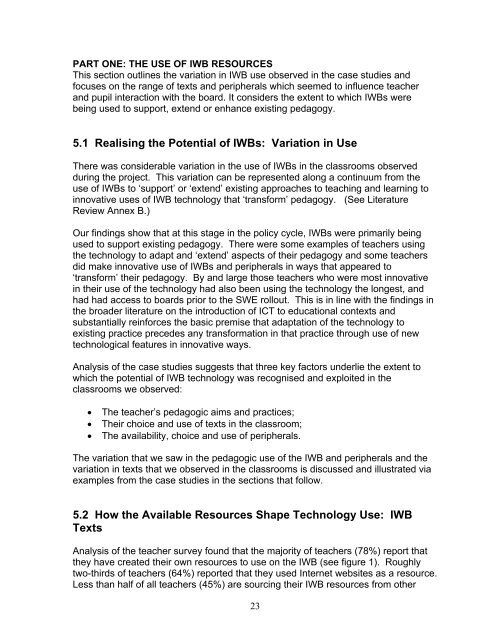The Interactive Whiteboards, Pedagogy and Pupil Performance ...
The Interactive Whiteboards, Pedagogy and Pupil Performance ...
The Interactive Whiteboards, Pedagogy and Pupil Performance ...
Create successful ePaper yourself
Turn your PDF publications into a flip-book with our unique Google optimized e-Paper software.
PART ONE: THE USE OF IWB RESOURCES<br />
This section outlines the variation in IWB use observed in the case studies <strong>and</strong><br />
focuses on the range of texts <strong>and</strong> peripherals which seemed to influence teacher<br />
<strong>and</strong> pupil interaction with the board. It considers the extent to which IWBs were<br />
being used to support, extend or enhance existing pedagogy.<br />
5.1 Realising the Potential of IWBs: Variation in Use<br />
<strong>The</strong>re was considerable variation in the use of IWBs in the classrooms observed<br />
during the project. This variation can be represented along a continuum from the<br />
use of IWBs to ‘support’ or ‘extend’ existing approaches to teaching <strong>and</strong> learning to<br />
innovative uses of IWB technology that ‘transform’ pedagogy. (See Literature<br />
Review Annex B.)<br />
Our findings show that at this stage in the policy cycle, IWBs were primarily being<br />
used to support existing pedagogy. <strong>The</strong>re were some examples of teachers using<br />
the technology to adapt <strong>and</strong> ‘extend’ aspects of their pedagogy <strong>and</strong> some teachers<br />
did make innovative use of IWBs <strong>and</strong> peripherals in ways that appeared to<br />
‘transform’ their pedagogy. By <strong>and</strong> large those teachers who were most innovative<br />
in their use of the technology had also been using the technology the longest, <strong>and</strong><br />
had had access to boards prior to the SWE rollout. This is in line with the findings in<br />
the broader literature on the introduction of ICT to educational contexts <strong>and</strong><br />
substantially reinforces the basic premise that adaptation of the technology to<br />
existing practice precedes any transformation in that practice through use of new<br />
technological features in innovative ways.<br />
Analysis of the case studies suggests that three key factors underlie the extent to<br />
which the potential of IWB technology was recognised <strong>and</strong> exploited in the<br />
classrooms we observed:<br />
• <strong>The</strong> teacher’s pedagogic aims <strong>and</strong> practices;<br />
• <strong>The</strong>ir choice <strong>and</strong> use of texts in the classroom;<br />
• <strong>The</strong> availability, choice <strong>and</strong> use of peripherals.<br />
<strong>The</strong> variation that we saw in the pedagogic use of the IWB <strong>and</strong> peripherals <strong>and</strong> the<br />
variation in texts that we observed in the classrooms is discussed <strong>and</strong> illustrated via<br />
examples from the case studies in the sections that follow.<br />
5.2 How the Available Resources Shape Technology Use: IWB<br />
Texts<br />
Analysis of the teacher survey found that the majority of teachers (78%) report that<br />
they have created their own resources to use on the IWB (see figure 1). Roughly<br />
two-thirds of teachers (64%) reported that they used Internet websites as a resource.<br />
Less than half of all teachers (45%) are sourcing their IWB resources from other<br />
23

















